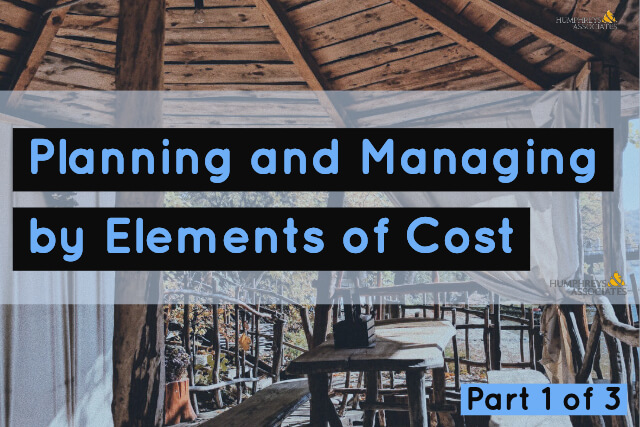Planning and Managing EVM by Elements of Cost (EOC) Example: Building a Backyard Patio – Part 1
by Humphreys & Associates | March 1, 2019 5:00 am
What are “Elements of Cost”?
Labor, Materials, Subcontracts, Other Direct Costs, and their Indirect Costs (Overhead including General and Administrative —G&A) are the typical building blocks for any project: personal projects and projects we manage for the customers we support. These items are also what the Earned Value Management System (EVMS) Guidelines call elements of cost (or EOCs). So, when the Guidelines call for us to plan and manage by EOC, it really should not cause us any undue anxiety – it is just the natural way to manage any project.
Example: Outdoor Backyard Patio
Let’s use a simple home project example of building an outdoor backyard patio: What do you have to do to determine how much it will cost for this Backyard Patio Project (BPP if you like acronyms)? Generally, you look at such things as:
- How much concrete; lumber for decking; nails, screws, bolts, washers, and other hardware, etc.; and weather-coating and paints/stains you will need (Material Element of Cost – EOC).
- Work you cannot do by yourself: electricity for lights and power, and natural gas for the Barbecue/fireplace (Subcontract EOC).
- Work you will do yourself (Labor EOC).
- Costs unique to this project’s completion, such as: Home Owners Association permits, building code permits, local excavation application fee, etc. (Other Direct Cost EOC).
- Costs incurred that do not necessarily go into the final product, such as: cleaning supplies, brooms, solvents, turpentine, weather tarpaulins, lighting and electricity, etc. (Indirect Costs/Overheads).
Unfortunately, when operating under the EVM requirement, often managers tend to overthink, and sometimes over apply the management of EOCs. Let’s look at the overthinking part first.
Overthinking EOCs
Guideline 9 of the EIA Standard 748 (Revision D) for EVM Systems requires:
- Establish budgets for authorized work with identification of significant cost elements (labor, material, etc.) as needed for internal management and for control of subcontractors.
Some might propose: “I’ll have one Work Package for the Control Account with all the EOCs in it, and I’ll be okay.” That might meet the intent of that first part of the guideline, but would probably fail the requirement that says “as needed for internal management and control of subcontractors.” For example, what EV technique would you use for a “work package” that had labor, material, and subcontract work in it? The labor occurs as the work is performed, the material might be earned at the point of receipt on the dock, and the subcontract might earn value with the receipt of an Integrated Program Management Data and Analysis Report (IPMDAR) dataset at the end of a month. Since the Control Account (CA) has one total dollar budget, the “identification of significant cost elements” has to occur at the Work Package (WP) and Planning Package (PP) level within the CA, which requires each WP and PP to be identified as one of the EOCs mentioned above.
For Instance
In our example, if we lumped concrete and lumber into one “Material WP” and we incurred a serious overrun in material, how would we identify what caused the overrun: the concrete pour or the lumber portion? These are different categories of material that would “earn value” (be accomplished) in different ways and at different times. In order to determine the “guilty party” in the overrun, we should also have separate WPs for the different significant material categories. Some might call these major, or high value, or critical material items, which should be tracked separately.
On the other hand, for the lower-value materials, it may not be significant enough to management to know that a variance might have been caused by a 1-cent washer or a pint of deck stain. Consequently, a grouping of these low-value material items may be all that is required for visibility. Conversely, Management might actually want to break out categories such as, separating the paints/stains, and weather-coating from the nuts, bolts, washers and other hardware, since they are different categories of low-value material that could also earn value differently.
Indirect Cost Rates Must be Applied Properly
For Indirect Costs, some contractors put the burden of planning and managing these overhead costs on the CAMs, while others apply the indirect rates at a summary level of the Work Breakdown Structure (WBS) or organizational structure. Regardless of how a particular contractor does it, the indirect cost rates must be applied properly to the various direct elements of cost:
- Material handling charges applied to material items
- Indirect Labor rates applied to the direct labor hours
- Subcontract overhead applied to the subcontract direct costs
- ODC overheads charged to the ODCs identified.
Applying and managing overheads at the CA level would entail hundreds of applications across the number of Control Accounts on a project, but applying these at a summary level would require only a handful of Overhead lines in reports. Doing so would significantly reduce the number of possible errors in application – which is why many contractors do not require CAMs to “manage” overheads in their Control Accounts. [Our BPP example does not have the above types of Indirect Costs that are related to specific Direct Costs, but it does have its own specific Overheads related to the labor to build the Patio.]
Humphreys & Associates is available for earned value training and consulting. Give us a call!
Source URL: https://blog.humphreys-assoc.com/planning-and-managing-evm-by-elements-of-cost-eoc-example-building-a-backyard-patio-part-1/
